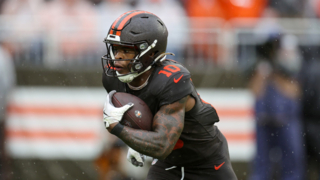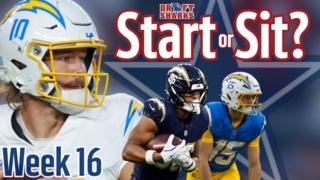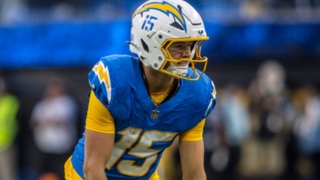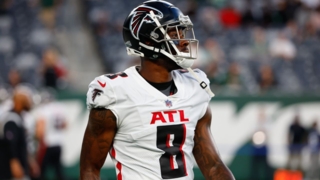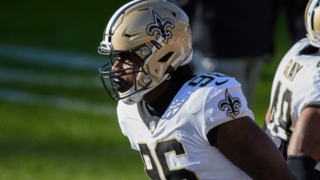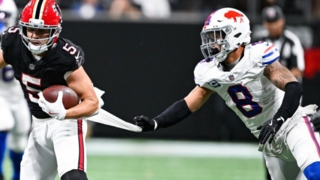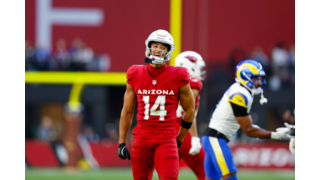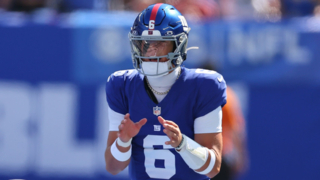When to Ignore Your 2018 Fantasy Football Rankings

If the MVP Board were my wife, we’d be arguing our way through the Scott Fish Bowl tournament.
In Round 1, I reached over all the recommendations at the top of my board to take Rob Gronkowski at 1.09. Two rounds later, I reached over top recommendation LeSean McCoy (and #2 Jordan Howard) to select Adam Thielen. (I’m now even happier I passed on McCoy but second-guessing the Howard decision.)
On the other hand, I followed the recommendations for Aaron Rodgers and Drew Brees in rounds 2 and 4 of what’s basically a 2-QB format. And I chose boring wideouts Michael Crabtree and Randall Cobb when they populated the suggested-player tiles.
I know you don’t really care about my team in this particular odd-scoring tournament. But my point is that I’m not married to the projections that drive the Board’s recommendations.
It’s a large-field tournament with 1 overall winner, so I’ll take a chance on Gronk late in Round 1 even when the board’s screaming RB. I really didn’t want to rely on McCoy this season even before Tuesday’s assault accusations, so I passed on him even when he was the value.
We put a lot of work into our projections before we roll them out, and we keep working on them throughout the summer, right up until no one’s drafting fantasy football teams anymore. But that doesn’t mean anyone should blindly follow what the board spits out.
There’s always room for personal preference: reaching a bit for a player you believe in, or simply want; passing on a guy who just rubs you the wrong way for 2018.
There’s knowing your league, which might always deliver early QB runs that have tended to leave you dissatisfied with your starter.
There are players we’ll be wrong about. Some guys will break out or bust, drastically out-producing or underperforming vs. where we project them. There will be injuries, presenting opportunities beyond what we can predict.
And even on players we get right, you might find 2 consecutive finishers in the rankings who perform differently in season. Perhaps they arrive at the same end-of-season fantasy-point total, but 1 did so in a predictable way that let you absorb his best starting weeks while the other volleyed between boom and bust all year.
That’s why we put together this article every year to give you a general idea of where to pay less attention to the rankings. Let’s get to it, by position ...
QB
If you’ve looked over our QB rankings, then you might have noticed how deep the position runs this year. There’s also not huge separation between tiers. Going by our default scoring, you have to look all the way down to Derek Carr at #26 and Eli Manning at #27 before you’ll find 2 players separated by more than 9 total points.
That means the top 25 options at QB are each separated from the next player by fewer than 0.6 points per game. So you can basically decide how to handle your QB situation.
Feel better about Matthew Stafford than the next 5 QBs on the board and not digging your options at other positions in Round 8? Take him. Think the next 6 QBs belong in the same tier with the guy your Board is recommending in Round 11? Keep waiting.
It’s a deep year at the position, which opens up myriad possibilities for how to approach QB in your draft.
The Board can prove particularly valuable in helping you decide when to take that 2nd QB in a 2-QB or superflex league, weighing the relative value of remaining options across positions. Of course, unusual formats can also make for less-predictable drafting patterns. So keep an eye on the QBs you want/like as you decide whether to follow the recommendations at each turn.
RB
How far into the draft can you reasonably expect to find RBs you’ll want to start pretty much every week? Probably about 4 rounds.
The top 17 RBs in our non-PPR rankings look fairly predictable in terms of their roles. We know they’ll work as their teams’ primary ball carriers, and most guys in this group will also lead their backfields in targets (commandingly so in many cases). Rashaad Penny -- at #18 -- could join the group depending on how training camp and the preseason play out.
Beyond that, though, lies plenty of uncertainty.
How much does Miami want to rely on Kenyan Drake (#19)? How many receptions will be available to Derrius Guice (#20) and Jay Ajayi (#21) -- and how much goal-line production can they get to mask any deficiency there? How will the workload splits fall in places such as New England, Denver, Green Bay and Detroit?
Some of these questions won’t be answered until we’re well into the regular season, but we’ll all need to decide where we want to take our shots or leave a situation to someone else.
Much could also come down to how you have built your roster. Did you start out with reliable building blocks? Maybe you’ll want to shoot for more upside at a couple of turns now. Did you already throw a couple of risky darts? Maybe it’s time for a safer volume bet such as Lamar Miller or Isaiah Crowell.
If you're looking to take some chances -- in any format -- the rookie RB class presents some key "ignore your projections" targets. We set all these young backs up with what seem like reasonable fantasy expectations, but none of us can really know just how much Sony Michel, Ronald Jones or Kerryon Johnson will get the ball in 2018.
On the PPR side, Alex Collins at #20 looks like the turning point for the same kinds of considerations -- ahead of all 3 rookie RBs I just mentioned.
WR
The WR rankings provide risk/reward and safer options at all levels. But somewhere in the 30s is where you can cut the tethers.
On both the PPR side and in non-PPR, Jamison Crowder looks like a good mile marker. He sits 36th in non-PPR, with Randall Cobb and Julian Edelman right behind him. Edelman’s value obviously hinges on whether you look at the full season or go weekly. Even his harshest critics likely wouldn’t project WR38 production over Edelman’s 12 available games. But exactly where to select him depends on your personal preferences.
Crowder climbs slightly to 33rd in PPR, with value option Rishard Matthews and lightning rod Jarvis Landry right behind him. Believe in Landry more than we do? If so, you’ll need to take him way before your MVP Board will recommend. Matthews, on the other hand, presents an opportunity to wait for value if you feel the same way we do about his outlook.
Of course, as you get further down the board, shooting for upside over floor will generally make more sense. Our “ceiling” projections can help highlight those guys in a range where full-season numbers might make everyone look the same.
Cameron Meredith, for example, leaps into WR3 territory if you sort your MVP Board by "ceiling." He presents a broad range of potential outcomes, but the higher end beats plenty of the guys going around (and before) him in fantasy drafts. Youngsters such as D.J. Moore, Kenny Golladay and Josh Doctson fit that category as well.
TE
Tight end can get a little crazy this year (or fun, or ugly … depending on your sense of adventure). And the feeling can set in pretty quickly.
There are arguably fewer than 10 “safe” starting fantasy bets regardless of scoring format. On the PPR side, we could argue down to Kyle Rudolph at 9 as relatively safe bets to control their teams’ TE targets and provide fairly reliable fantasy production.
After Rudolph, though, comes Jack Doyle. And even if you’re like me and prefer him easily over Eric Ebron, we can’t ignore the possibility that Indy has plans to deliver on the early Ebron buzz.
Then comes Trey Burton. He steps into a more clearly defined role with the Bears but has never been a featured receiver at any level and will play for a 1st-time HC and 1st-time OC alongside a 2nd-year QB. We’re all just guessing what the Chicago offense would look like.
Heck, even within our top 9 sits Jordan Reed, who you’ll either see as a strong value or a hands-off come draft day.
On the non-PPR side sits Evan Engram at 7. If you listen to the podcast regularly, you might have already heard our pessimism on him multiple times. But he’ll likely emerge as the 2nd or 3rd option in the Giants’ passing game this year. And right behind him sits Reed, Burton and Doyle, in a range with Rudolph and Tyler Eifert. That group presents chances to go in a number of directions with your draft.
And what you do beyond that will depend on how many TEs you plan to draft along with other specifics on your league’s format.
We build the MVP Board every year to help guide you through your drafts. Just keep in mind that it’s a guide -- and not something you’re married to.
Draft using the best dynamic tool in the industry. Our fantasy player valuations (3D Values) change during your draft in response to...
- Exact league settings - direct sync
- Opponent and Team Needs
- Positional scarcity & available players
- Ceiling, injury risk, ADP, and more!
You need a dynamic cheat sheet that easily live-syncs with your draft board and adapts throughout your draft using 17 crucial indicators.
Get your Draft War Room Today
 Redraft
Redraft Dynasty
Dynasty Best Ball
Best Ball